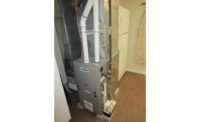What equipment gets tested, how it gets tested, why and when it gets tested, and what standard those results are held up against … these factors can shape the HVAC equipment market right along with actual performance. The Department of Energy (DOE) guidance for these things is often called the Process Rule.
On Feb. 13, the DOE filed a notice of proposed rulemaking (NOPR) to give the Process Rule some updates. As the “proposed” wording indicates, the decisions involved are tentative, pending a hearing on March 21. However, the NOPR comes after a well-populated round of industry feedback on the matters in question, and the DOE is likely to enact them collectively.
While the NOPR itself offered thorough accounts of stakeholder feedback and DOE deliberation on the several areas it is working to refine in this effort, the Air-Conditioning, Heating and Refrigeration Institute (AHRI) had no problem identifying what it considers the highlight.
“We are pleased that it includes one of our most important priorities: requiring the establishment of equipment test procedures prior to updating efficiency standards,” said Stephen Yurek, AHRI president and CEO.
“That step alone,” he said, “is a significant improvement over prior practice.”
Although no length has been specified until now, the existing Process Rule does dictate that the DOE should finalize the testing procedure prior to announcing any standards rulemaking.
Problems arose, as the NOPR acknowledged, when the DOE would occasionally announce the testing detail and rulemaking intent at the same time. The agency’s recommitment to earlier test procedure finalization for pursuing any new or amended standards, and attaching a formal 180-day lead time to that commitment, will be welcomed by manufacturers.
One such manufacturer is Danfoss.
“It is imperative that DOE finalize the test procedures upon which the standard will be based well before tackling the standard itself,” said Mark Menzer, director of public affairs, Danfoss.
STAKEHOLDER INPUT
Menzer identified another potentially meaningful decision in the NOPR. If deciding how to craft a standard is important, the decision about whether or not to even do anything may be more important.
Based on the agency’s intent, “DOE will determine early in the process whether no new efficiency standard is needed, based upon their cost/benefit evaluation,” Menzer said. “This is appropriate: Equipment that saves energy but will be priced beyond the means of most consumers does not help the U.S. save energy.”
The Process Rule presently includes a list of 10 factors to be considered in sequence when it comes to what standards or proposals to address. Stakeholder input is seventh on that list.
The agency indicates that incorporating industry feedback earlier in deliberations might lead to better decision-making early on.
“Going forward, stakeholders would have the opportunity to provide input on prioritization of rulemakings through a request for comment as DOE begins preparation of its Regulatory Agenda each spring,” the NOPR stated. “In particular, DOE would point interested parties to the Regulatory Agenda posted to www.reginfo.gov the previous fall and would request input concerning which rulemaking proceedings should be in particular action categories in the spring Regulatory Agenda and the timing of such rulemakings.”
DOE reiterated an emphasis on early stakeholder input and an intent to request information about whether any new standard is economically justified, is technologically feasible, or would result in a significant savings of energy.
WORTH THE EFFORT
The concept of “a significant savings of energy” as a threshold for amending existing standards has been a lively topic of conversation at times.
At a DOE public meeting in January 2018, multiple industry commenters supported such a benchmark. AHRI endorsed the idea if for no other reason than to best deploy DOE’s resources.
Part of the question has been whether justification should rely on the raw expected amount of energy savings or on a percentage comparison to current use.
Ice-O-Matic made a case that previous DOE decisions had required large time investments that were not justified by the resulting energy savings, resulting in negative impacts on consumers due to higher product and equipment prices.
Similarly, the American Boiler Manufacturers Association (ABMA) had suggested that, as worded by DOE, “current boiler designs may be close to the point of diminishing returns” regarding potential efficiency gains.
With this NOPR, the DOE stated its intent to apply a “hybrid” threshold-based analysis that would examine energy savings through the twin lenses of the total amount of project energy savings and the relative percentage increase in efficiency/decrease in energy usage that could be obtained by amending a given standard.
CONSUMER GOOSE, COMMERCIAL GANDER
It may surprise some to learn that despite common application to commercial equipment, the Process Rule as written only refers to consumer products.
Industry commenters on the whole supported expanding the formal scope to commercial equipment as well (with traditional modifications for “ASHRAE equipment”), but the sentiment was not unanimous.
ABMA pointed out that many of its members’ products do not resemble their commercial counterparts in terms of size, complexity, and application, to name just a few distinctions.
Further, ABMA observed that the most application-specific, largest equipment may have sales in the single digits annually in some instances and warrants a different approach.
Ultimately, the DOE perceived more benefit in the consistency of applying the Process Rule to both sectors. The agency posited that more concrete timeframes discussed elsewhere in the NOPR may enhance the consideration given to more unique equipment.
BEYOND ASHRAE?
Standing guidance has been that DOE must adopt any ASHRAE amendments to Standard 90.1 efficiency requirements. Related, it requires “clear and convincing evidence” in order for DOE to set performance requirements that exceed those levels.
A group of commenters referred to as Joint Commenters pointed to a more recent trend of DOE decisions that have, in fact, exceeded ASHRAE 90.1. The Joint Commenters specifically pointed to one example of rulemaking regarding single-package, vertical units.
DOE uses this NOPR to reinforce the “clear and convincing evidence” bar for such exceptions. DOE would need to have “no substantial doubt” that a more demanding standard would clear the usual technology, efficiency, and economics concerns.
As a result, DOE expects that “only in extraordinary circumstances” would the agency exceed ASHRAE recommendations. In total, the DOE disposition signals a “never say never, but …” philosophy that will likely ease industry concerns about DOE inclinations to set more ambitious minimums than ASHRAE.
Traditionally, this area of ASHRAE-related modifications to the Process Rule has applied when it comes to equipment such as commercial water heaters, commercial packaged boilers, commercial HVAC equipment, and packaged air conditioners and heat pumps.
WORD FOR WORD
Speaking of ASHRAE standards, the DOE noted that the current Process Rule does not account for “verbatim adoption” of industry standards.
Some comment here has surrounded the issue of occasional alterations to industry wording to reflect differences in test procedures and minor factors.
The DOE’s updated position reflects a desire to require verbatim adoption of appropriate industry standards. With an eye toward reducing the circumstances in which wording has required changes in the past, DOE also used this NOPR to request comment to identify any of its own test procedures that should be adopted to match the industry tests.
SUM OF ITS PARTS
A document like the latest NOPR is by necessity dense, technical, and somewhat bureaucratic. However, the early returns are positive.
“Manufacturers need certainty in planning for the future, and contractors need stability,” Menzer reinforced. “The changes proposed by DOE will lead to more logical standards and provide a greater certainty than we have experienced in the past.”
Publication date: 3/11/2019
Want more HVAC industry news and information? Join The NEWS on Facebook, Twitter, and LinkedIn today!








